Читать книгу Conversational Japanese - Anne Kaneko - Страница 6
На сайте Литреса книга снята с продажи.
ОглавлениеIntroduction
This is a book about communication. As we all know, communication is more than just language. Our body language is just as important, and we all bring a host of personal and cultural baggage to each conversation we have. To communicate successfully in another culture we need more than the bare bones of the language. We need to understand the given norms of that society, how people interact, how things work, what the system is, how to navigate and manipulate those systems--in short, how to use the language in context.
This book aims to prepare you for situations you are likely to find yourself in if you go to Japan to visit or to work. I’ve worked on the assumption that if you know in advance what is likely to crop up you’ll be better able to function successfully than if you come cold to a situation. Every chapter starts with a short introduction giving background knowledge for that topic; then there are dialogues based on real-life situations which give you the words and phrases you need to manage a wide range of daily tasks from getting on with the neighbors, to buying a phone, shopping on the internet, sightseeing, visiting clients or giving a speech. Many of the tasks we have to perform, such as dealing with immigration, filing a tax return or even filling up with gasoline require specialist vocabulary, and I’ve included that too.
This is not a programmed language course; rather, it is aimed at people who have taken such a course or have otherwise mastered the basics of the language, though I hope that even beginners picking up this book will gain confidence and proficiency in interacting with the Japanese in many ordinary situations. I hope this book fills a gap, is interesting and fun to read, and serves as a stimulus to further study. I’ve tried to keep the language simple and clear and strike a balance between textbook Japanese and the colloquial language. Real life conversations are untidy and elliptical. You’ll find people use far more contractions than I have done, omit particles, and add extra particles and nouns to the end of sentences. I’ve done this to a certain extent but in real life there will be much more.
One of the difficulties in spoken Japanese is the wide range of language, from informal to very formal. The examples in this book are standard Japanese (although in most cases the sentences are softened with informal endings). The language does veer on the polite side but you can always tone it down after observing how other people speak. It's better to start this way than be too familiar at the outset. And there are bound to be occasions when you need to summon all your linguistic talents to make a good impression. Even Japanese new recruits are put through their paces on their first day at the office, learning how to bow properly, answer the phone and use respect language correctly!
Unlike most language books, Conversational Japanese does not restrict the use of kanji (Chinese characters), and the sentences are written in the usual Japanese combination of kana and kanji. I realize that learning kanji is a mammoth task but I hope that by using the romaji that is included for each word or phrase, you will find that you can read more than you think, that as you go along the kanji become easier to read and easier to remember, and that you can pick up new kanji over time. Perhaps you already know a word but not the character: seeing the kanji might give you a new insight into the meaning. This can be a eureka moment, and is the fascination of the language.
I am very grateful to the publishers, Tuttle Publishing, for giving me this opportunity to pass on my knowledge to a new generation. I hope this book will, in a small way, help people get more out of their stay in Japan, help them understand Japan better and communicate more meaningfully.
The dialogues in this book are presented by a diverse group of characters. We have Lin Wenbao, a postgraduate student from Shanghai; Max and Kate Brown, English teachers from the UK living in Sendai; Kim Young Hee, a young woman from South Korea; and Michael and Emily Taylor, from the United States. There are also Japanese characters with whom they work and interact.
I am indebted to all those past and present whom I have known over the years and who directly and indirectly contributed to my knowledge of the language and the book. All the mistakes, omissions etc. are obviously my own.
Anne Kaneko
Koriyama, Japan
October 2010
